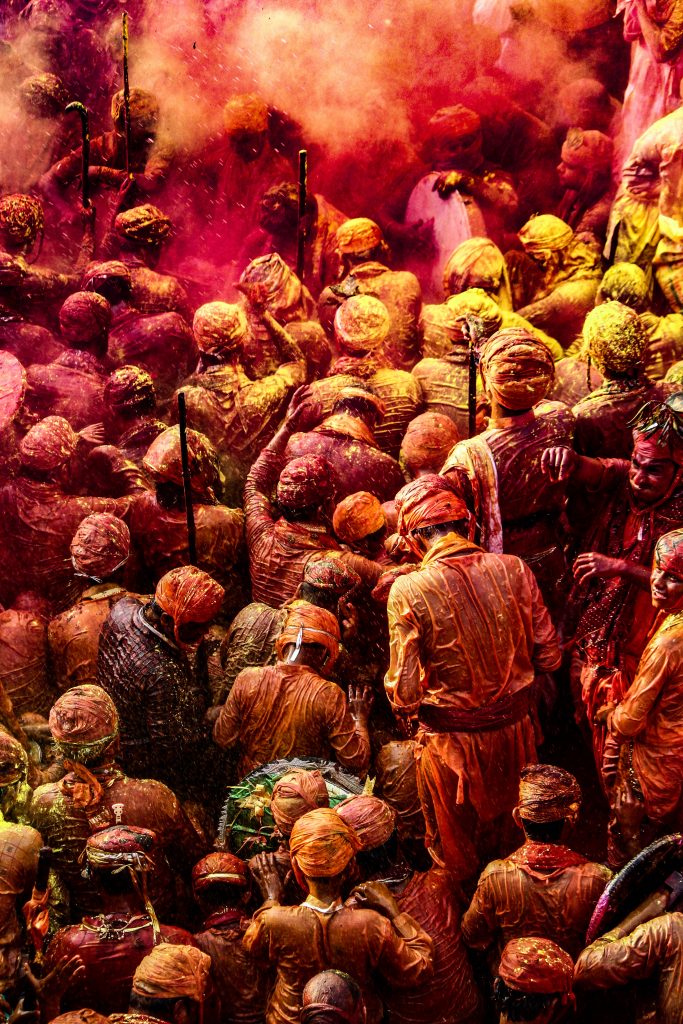Holi, also known as the Festival of Colours, is a significant yearly Hindu festival. It takes place on Friday 18th March this year and marks the arrival of spring. It’s one of the most significant Hindu festivals and if you hadn’t already guessed, it involves lots of colour!
During the festival, Hindus will use a mix of bright coloured powders to cover each other. The festival lasts for two days and in addition to marking the arrival of spring, Holi is also about celebrating Hindu god Vishnu and the legend of Holika and Prahlad. There is also the love story of Krishna and Radha that led to the throwing of coloured powders. I explain more about the historic stories behind Holi below.

Good triumphs evil
The first legend behind Holi is all to do with good vs evil.
Prahlad was the son of an evil king. The king told his people that he was also a god and that they had to worship him. Prahlad also believed that his father was a god and joined the rest of the people in worshipping his evil father.
One day when Prahlad was walking, he saw a woman who was praying next to a well. Her cats had fallen into the well and she was praying to Vishnu (a Hindu god) for her cats to be safe and escape the well.
Prahlad told the woman that she should be worshipping the king, who is their god and not Vishnu.
After a few moments, one by one, each cat crawled out of the well and returned to their thankful owner. Prahlad realised that his father was not actually a god, and that he should worship the actual god, Vishnu, who had saved the cats.
Prahlad’s father found out what his son was thinking and he arranged for him to be thrown off a cliff. As Prahlad fell, he prayed to Vishnu for help. Vishnu heard his prayers and ensured his landing was soft so that he wasn’t hurt.
When the king realised his son was still alive, he had him thrown into a snake pit with hundreds of snakes. Once again, Prahlad prayed to Vishnu and the snakes didn’t harm him.
Next, he was put with a herd of elephants who were taunted and encouraged to trample on Prahlad. He prayed to Vishnu and the elephants all stopped as they reached him.
The king and Prahlad’s sister, Holika, hatched a plan to lure Prahald into a fire. Holika said that her magic powers would prevent her from burning and protect her.
A huge bonfire was built and Holika dared Prahlad to follow her into the fire. Holika was in fact right, her magic powers did prevent her from burning but as Prahlad stepped into the fire, Vishnu transferred the magic powers from Holika to her brother and he survived the fire. Holika did not.
This story is still remembered to this day. On the eve of Holi, fires are lit to represent the burning of Holika whilst remembering the story of how good triumphs over evil.

The colourful element of Holi which stems from the throwing of coloured powders known as gulal comes from a different historic story. Krishna, who is another incarnation of the god Vishnu, had blue skin. He was in love with someone named Radha. However, Krishna was embarrassed that his skin was blue and Radha’s wasn’t. With help from his mother, he coloured Radha’s face with blue paint so that they looked alike and fell in love. This story led to the throwing of gulal in modern celebrations.
Celebrating Holi – The Festival of Colours
Celebrations of Holi may vary around the world however one common theme between them all, is colour! You’ll likely find people covering each other in coloured paint and powders. A little tip from experience, I wouldn’t wear your best outfit if you are celebrating Holi! The colours will never come out and your hair will likely stay coloured for a few days. It’s really fun though so it’s worth it.
Each different colour that is used during Holi holds a different meaning although the meanings do vary in different cultures/areas.
- Blue – the face of Krishna and also the sky
- Red – love
- Yellow – intelligence and knowledge
- Green – nature
- Pink – compassion
- Purple – mystery
In India, the streets are usually full of people having what can be described as a huge snowball fight, but with coloured powders instead of snow.
There’s no area of the body that’s really off limits, you should aim to end the day fully covered in colour from head to toe.
As I mentioned above with the story of Prahlad and Holika, fire is burnt on the eve of Holi symbolising the burning of Holika. ‘Holika Dahan’ is celebrated with wood that has been collected in the build up to the festival. Families celebrating will often create a look-alike figure of Holika to represent the traditional story.
The colourful fun then takes place on the main day of Holi.
Across the UK, Holi is often celebrated, although activities have unfortunately been disrupted by the pandemic over the last two years.
In previous years, the University and its Asian societies have gotten together outside of University House and held a fantastic festival event with plenty of colour throwing involved. (As you can see in the above video!)

Manchester is a diverse city and includes a large Indian community. The city has held its own Festival Of Colours previously which has had over 25,000 participants at both Heaton Park and Platt Fields Park. The event includes various stalls, music and of course, the opportunity to get involved with the gulal throwing.
It’s definitely something to add to your bucket list when events restart, but in the meantime I hope you found this article interesting, and I would like to wish you all a Happy Holi!





Leave a Reply